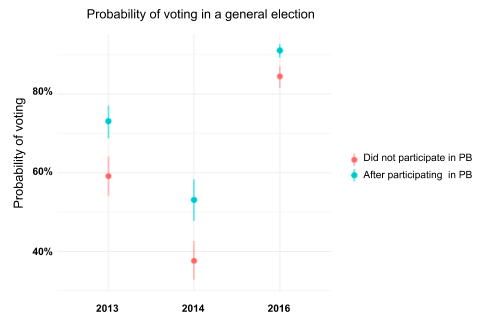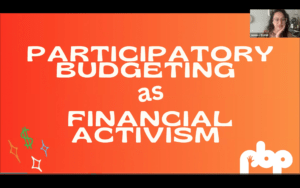The effects of PB on voter likelihood
Trust in government is at an all-time low, as only 18% of Americans say they can trust the government to do what is right. This deep distrust and cynicism leads many to stay home on election day. The US has one of the lowest rates of voting among the voting age population in developed countries.
New research shows that participatory budgeting (PB) is an effective way to increase engagement in elections, making people 7% more likely to vote.
PB is a process in which community members directly decide how to spend public money. Everyday people come up with ideas to improve their community and vote to decide which ideas to fund. PB has been recognized by the Obama White House, Harvard University, and the United Nations as a proven tool for increasing trust and engagement in government.
So, does PB make people more likely to vote in elections?
Indeed, youth in Boston report that as a result of participating in PB, they are more likely to vote in other elections. Yet existing data on this question is sparse, and relies on what people say they will do, rather than measuring what they actually do.
Study
To answer this question, Dr. Carolina Johnson, an independent Seattle-based researcher and PB Research Board member, Sonya Reynolds, NY Civic Engagement Table Data Director and PBNYC Citywide Committee Co-Chair, and H. Jacob Carlson, PhD candidate in Sociology at the University of Wisconsin – Madison, conducted a study of people who voted in PB and people who didn’t vote in PB in New York City. The research team collected PB voter lists from New York City Council district offices. They focused on two districts that had the most complete data, District 39 and District 23. They then matched those PB voters to their New York State Voter File record to obtain their past voting history, including whether they voted after participating in PB.
The first analysis looked at voters individually, to determine if someone was more likely to vote in a regular election if they had voted in PB in the past.
This first analysis is useful, but to understand the effect of PB on voting, you should compare someone who voted in PB with someone who didn’t vote in PB.
How do you do that?
You can’t create a typical “lab experiment”, since you couldn’t randomly assign someone to vote in PB. Instead, the researchers used statistical “matching” techniques to simulate such an experiment. They matched each PB voter with another similar person in the voter file who couldn’t vote in PB because their district wasn’t participating. They matched PB and non-PB voters using data that are common predictors of electoral voter turnout – age, race, sex, and past voting history. Because communities vary with respect to voter turnout, they matched people from neighborhoods with similar racial composition, income, and education, and individuals with similar voting histories – whether they voted frequently or never.
Through this more precise methodology, the research found that people who vote in PB are on average 7% more likely to vote in subsequent elections.
The graph below shows how the probability of electoral voting increases when someone has voted in PB, separated by election year. The larger the gap shown in the graph, the bigger the effect of PB on someone’s likelihood of voting in an election.

Implications
These new findings show that PB reinvigorates people’s civic participation and increases voter turnout.
They validate what we hear from participants about how PB leads people to want to be more involved in the civic life of their communities. As one participant said after their first PB experience:
“Well, I always saw [the Council member] really positively, but this made me feel more confident because [they are] doing pretty good work. I will get involved with PB and with lots of other things too, definitely.”
As PB is expanding to schools, students are learning about democratic participation, and are registering to vote. Through the Phoenix Union High School District’s (PUHSD) PB process, organizers registered 786 high school students to vote in 2018. Cyndi Tercero, lead coordinator of PUHSD PB, says “If they were able to do this in their school…can you imagine if they used their voice at the community level? We are creating students who are going to be leaders in their community.”
Stay tuned for a forthcoming working paper with more details on this study.






One Response
Beautiful! In a time for us as Nashvillians, this is just what Metro Nashville Community Budgeting wants to show! Thanks for sharing PB Project!